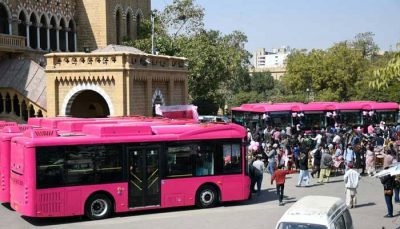In many developing countries like Pakistan, the state’s capability to implement reform initiatives has been constrained by ‘capability traps’, where the government has failed to achieve sustained improvements in performance because there has been greater focus on changing what policies and organisational structures look like rather than what they actually do. This has created a growing need to identify locally-nominated problems and actively engage with agents on ground, instead of importing pre-packaged best practice solutions from other countries.
In Pakistan, ever since the 18th amendment, provinces now have greater autonomy to direct resources and capabilities by adopting a more adaptive policy making approach for strengthening public service delivery. The Consortium for Development Policy Research in partnership with the International Growth Center (IGC) and the Sustainable Energy and Economic Development (SEED) organized a Policy Exchange talk, focused on ‘Adaptive Policy Making,’ bringing together a panel of experts to discuss Harvard University’s latest research on state building capacity, known as the Problem Driven Iterative Adaptation (PDIA), and understand how it can transform policy making in Pakistan, particularly in the province of Khyber Pakhtunkhwa (KP).
What is Problem Driven Iterative Adaptation (PDIA)?
Problem Driven Iterative Adaptation (PDIA) is a decision-making process that emphasizes on defining the problem first, rather than seeking solutions, to enable policymakers to cumulatively take steps in the right direction. It can be differentiated from the dominant paradigms of building state capability in three essential ways:
PDIA is an organisational process
PDIA undertakes an organizational approach, where it assumes that the government is an organisation, in contrast to other dominant state capability building approaches, which respond through a policy process, independent of the organizational structure. Hence, PDIA’s main focus is on enhancing organizational rather than the individual agent’s capacity because it assumes that if individuals are better embedded in the organizational processes and practices then their individual capacities will also be brought out.
PDIA is a purpose-driven approach
It is also important to note that previously dominant state capacity building approaches were more inclined towards a process compliance-driven decision-making process, which assumes that employees already understand the organization’s culture and only require capacity enhancement to solve problems. However, this approach has resulted in delays in apt decision making as agents in the organisation are not able to effectively articulate the organisational purpose, and are overly bound by regulations, waiting for directions from higher ups. PDIA, on the other hand, opts for a more problem-driven or purpose-driven approach for organisational capability enhancement. It focuses on first defining the organisation’s purpose, identifying the problem and then proceeding towards capacity building. This sets clear direction for where the organisation needs to build capacity to fulfil its purposes, and articulates what needs to be learned by the agents to gear up and tackle the problem; in other words, everyone’s role in the organisation becomes clear, leading to greater empowerment.
PDIA is a capacity building approach
With regards to capacity building, governments in Pakistan have traditionally undertaken an individual capacity building direction, where initiatives like training programs, start with the presumption that agents within the organization do not have capacity. This is different from the PDIA approach, which is based on the idea that capability cannot be built without understanding the purpose or problem behind it. For instance, before investing in training programs for police officers in KP, it is important to identify the key problems the police system encounters in the provinces. Hence, the problem identification stage in PDIA is essential for defining the purpose, and the problem should be carefully constructed to then identify what capabilities need to be enhanced. In this way the purpose of the organization is internalized by the agents of the organization as well as outlined beyond the organization to the supportive infrastructure, consisting of the governmental and social forces – leading to acceptance and ownership of the problem as defined by the organization as well as decentralized decision making.
KP’s Experience with PDIA Adoption
Post-18th amendment, provincial governments have enhanced discretion to drive policy and public expenditure decisions. The KP government was also able to spend more on key sectors like education, health and the police. Investments in the education sector increased by 350% to improve monitoring and inspections, while health sector investments also rose by 70%, particularly at the tertiary care level. Furthermore, investments were made to improve the police culture and the overall criminal justice system due to the security concerns emphasized by the previous government and general public in KP; as a result, the police system in KP has been lauded all across the country.
Despite efforts to enhance adaptive policy making in KP, the province still has a long way to go. Hence, it is important to highlight the following challenges and recommendations to improve adoption of PDIA in KP:
Difficulty in Changing the Organizational Culture
The organizational culture in KP is difficult to change, which has led to resistance to the adoption of PDIA as an adaptive policy making approach. As organizations in Pakistan are dealing with decades of low levels of performance, a ‘stick’ approach, where regulatory pressure is applied from the outside, has not been successful in changing organizational culture. Organizational transformation needs to be unleashed from within, where PDIA can be used as an important tool for identifying problems from inside the organization.
Punjab’s experience with the Section 42 companies, particularly the Punjab Skills Development Fund (PSDF) is important to note here, as it allowed the creation of a policy design space, which does not follow the usual rules of business for public sector organisations. This major organizational change enabled the experimentation of different policy designs and innovative skills programs based on evidence on ground. Learning from Punjab’s experience, KP has also allocated resources for the creation of a similar skills development organisation.
Misalignment of Interests between Political Elite and General Public
KP has encountered a mismatch between the problems identified and spent on by the political leadership and the actual on-ground realities of the general public. Results from the recent perception surveys in KP show that the public is more concerned with issues related to unemployment, inflation, electricity and gas, whereas the political elite mainly propose investments in areas of road development, water supply management and irrigation systems. This misalignment between actual needs and provincial spending is a result of a ‘capability-first’ mind-set of the political elite, who focus more on tackling development needs in areas where they already have built capability i.e. spending on logistical tasks that earn political mileage and visibility, but do not require organizational reordering for maximising development outcomes. This sort of logistical spending, though attractive to the political elite, is not aligned with the overall growth agenda of the province and does little to solve complex problems people actually face.
This misalignment of interests can be resolved in two essential ways: firstly, by ensuring the active involvement of all political economy actors in the problem identification process, and secondly, by setting a clear distinction between public spending and actual investment. In the former case, it is important to understand that problem identification in PDIA is a political process, which necessitates the involvement and authorization from all key stakeholders, and accounts for all political economy constraints in the construction of the problem. Hence, effectively using the Triple A framework of the PDIA approach becomes necessary in KP’s reform space to ensure that there is support for building state capacity (authority) , acceptance for this policy change (acceptance), and skills set, time and funding are available to support the proposed intervention (ability). It is interesting to note that KP has already started integrating PDIA in its Annual Development Policy, as it proposes no Chief Minister-directed or constituency-based spending, and aims to take on a sectorial problem identification approach, with close consultation with the elected leadership.
On the other hand, it is also important to prompt policymakers to sequence and sift out development priorities, and give the highest attention to those whose gains translate into an actual increase in social welfare. With this aim, the government will have to empower entire organisational structures – not just its leadership – to work as a synergy that prioritises capability enhancement as and when needed for addressing non-traditional problems.
Mind-set of Civil Servants
Changing the mind-set of civil servants and the manner in which they work is a key challenge in KP, which points to the need to move from a strict accounting-based accountability towards account-based accountability. While improving “accountability” is necessary for improving public sector performance, provincial governments in Pakistan have traditionally followed an accounting-based accountability approach, which is only focused on strengthening top-down managerial control and instilling a control modality into the civil servants’ mind-set. While, this approach is sometimes useful in managing logistical tasks like building a road, it fails to offer much discretion or autonomy to civil servants – losing on the benefits of provincial decentralization and opportunities of engagement with the local government, general public, and frontline organizations and agents.
PDIA instead proposes an account-based accountability model, which focuses on understanding what needs to happen to the everyday processes and how, as part of the PDIA process, high performing civil servants can be enabled with a different version of what they could do and achieve greater power and autonomy to innovate. The fundamental idea behind this approach is to provide an account, which is a narrative that explains what happened and why, and how others can form a judgment about whether the actions were appropriate, rather than just follow top-rules and procedures.
Tendency to Focus on Solutions
Preconceived notions of directly looking for solutions, rather than the whole value chain to find actual problems, has also been a key barrier to the adoption of PDIA in KP. The Bus Rapid Transit (BRT) project in KP is also an example where the tendency to expedite the process to achieve solutions or quick recognition was a problem rather than the actual technical design of the project. This indicates that the government’s focus is more on spending rather than the process or the output. Similarly, many departments in KP were also not able to track their progress in terms of output due to lack of data and baseline evidence. Furthermore, in cases where the unit cost of delivery was high, focus on spending has prevented departments from changing their strategy. Hence, it has become increasingly important to identify organizational purposes and divert focus towards output or the process rather than spending.
Need to think local
It is pertinent to recognize the limits to external validity and move away from the tendency to import international best practices, without keeping the local context into consideration. This also applies to the case of federal and provincial power distribution, where PDIA is employed at the provincial level to discover innovation through decentralization, while its implementation continues to be top-down.
Hence, it becomes necessary to embrace a diffusion mentality – where the fusion of success is horizontal, and based on the account of those who are similarly situated and performing well. This entails the adoption of a process which has led to success in for instance, a certain hospital, school or police district, as opposed to adopting its particular practice. This also means that despite greater autonomy and allocation of resources to the provincial governments, there is a need to further delegate at the local level to instill real change. While decentralization at the local government level aids better problem identification and decision making, it also entails a re-imagination of the role of the federal government and ministries in facilitating the provinces.




